American projects Atomic
In the late forties, the former allies in the war with Germany and Japan - the United States and the USSR - suddenly became the worst enemies. The geographical features of the mutual location of both countries required the creation of strategic bombers with an intercontinental range. The old equipment was already unable to deliver atomic ammunition to another continent, which required the creation of new aircraft, the development of rocket technology, etc. Already in the forties, the idea of installing a nuclear reactor on an airplane had matured in the minds of American engineers. Calculations of that time showed that at one refueling with nuclear fuel, an aircraft comparable in weight, size and flight parameters to a B-29 bomber would be able to spend at least five thousand hours in the air. In other words, even with the then imperfect technologies, a nuclear reactor on board with just one fueling could provide the aircraft with energy throughout its life.
The second advantage of the hypothetical atom aircraft of that time was the temperature reached by the reactor. With proper design of a nuclear power plant, existing turbojets could be improved by heating the working substance with a reactor. Thus, it became possible to increase the energy of jet gases of the engine and their temperature, which would lead to a significant increase in the thrust of such an engine. As a result of all theoretical reflections and calculations, aircraft with nuclear engines in some heads turned into a universal and invincible means of delivering atomic bombs. However, further practical work cooled the ardor of such "dreamers".
NEPA program
Back in 1946, the newly formed US Department of Defense launched the NEPA project (Nuclear Energy for the Propulsion of Aircraft). The purpose of this program was to study all aspects of promising nuclear power plants for aircraft. Fairchild has been nominated as the lead contractor for the NEPA program. She was instructed to study the prospects of strategic bombers and high-speed reconnaissance aircraft equipped with nuclear power plants, as well as to shape the latter. Employees of Fairchild decided to start work on the program from the most pressing issue: the safety of pilots and support staff. To do this, in the cargo compartment of the bomber used as a flying laboratory, put a capsule with a few grams of radium. Instead of a part of the regular crew, employees of the company “armed” with Geiger counters took part in experimental flights. Despite the relatively small amount of radioactive metal in the cargo compartment, the background radiation exceeded the permissible level in all habitable volumes of the aircraft. Based on the results of these studies, Fairchild employees had to sit down at the calculations and find out what protection the reactor would need to ensure adequate security. Already preliminary calculations clearly showed that the B-29 aircraft simply could not carry such a mass, and the volume of the existing cargo compartment would not allow the reactor to be placed without dismantling the bomb racks. In other words, in the case of the B-29, one would have to choose between a long range (and then, in a very distant future) and at least some payload.
Further work on the creation of a preliminary design of an aviation reactor encountered new and new problems. Following unacceptable mass and dimensional parameters, difficulties arose with controlling the reactor in flight, effective protection of the crew and the structure, transfer of power from the reactor to the propulsion and so on. Finally, it turned out that even with sufficiently serious protection, radiation from the reactor could adversely affect the aircraft’s power set and even engine lubrication, not to mention electronic equipment and the crew. According to the results of the preliminary work, the NEPA program for the 1948 year, despite spending ten million dollars, had very doubtful results. In the summer of 48, the Massachusetts Institute of Technology held a closed conference on the prospects of nuclear power plants for aircraft. After a series of disputes and consultations, the engineers and scientists participating in the event came to the conclusion that it was possible in principle to create an aircraft, but its first flights were attributed only to the mid-sixties or even to an even later date.
At the conference at MIT, it was announced the creation of two concepts of promising nuclear engines, open and closed. An “open” nuclear jet engine was a kind of conventional turbojet, in which the incoming air is heated using a hot nuclear reactor. The hot air was ejected through the nozzle, simultaneously rotating the turbine. The latter set in motion the impeller of the compressor. Immediately, the disadvantages of such a system were specified. Because of the need for air contact with the heating parts of the reactor, special issues caused the nuclear safety of the entire system. In addition, for an acceptable layout of the aircraft, the reactor of such an engine had to be very, very small, which affected its power and level of protection.
The nuclear jet engine of the closed type had to work in a similar way, with the difference that the air inside the engine would be heated upon contact with the reactor itself, but in a special heat exchanger. Directly from the reactor in this case, it was proposed to heat a certain coolant, and the air had to pick up the temperature upon contact with the radiators of the primary circuit inside the engine. The turbine and compressor remained in place and worked in the same way as on turbo-jets or on open-type nuclear engines. The engine of the closed circuit did not impose special restrictions on the dimensions of the reactor and allowed to significantly reduce emissions to the environment. On the other hand, a particular problem was the selection of coolant for the transfer of reactor energy to air. Different heat-transfer fluids did not provide proper efficiency, and metal ones required pre-heating before engine start.
During the conference, several original techniques were proposed to increase the level of crew protection. First of all, they concerned the creation of power elements of the corresponding design, which would independently shield the crew from the radiation of the reactor. Less optimistic scientists suggested not to risk pilots or, at least, their reproductive function. Therefore, there was a proposal to ensure the highest possible level of protection, and crews to recruit from older pilots. Finally, ideas emerged concerning the equipping of a prospective nuclear aircraft with a remote control system so that people during the flight would not risk their health at all. During the discussion of the last option, an idea emerged to place the crew in a small glider, which was to be towed behind the aircraft on a cable of sufficient length.
ANP program
The conference at MIT, serving as a kind of brainstorming session, had a positive effect on the further course of the atomic-powered aircraft program. In the middle of 49th year, the US military department launched a new program called ANP (Aircraft Nuclear Propulsion - "Aviation nuclear propulsion system"). This time, the work plan involved the preparation of a full-fledged aircraft with a nuclear power plant on board. Due to other priorities, the list of enterprises employed in the program has been changed. Thus, Lockheed and Convair were hired to develop the airframe of a promising aircraft, and General Electric and Pratt & Whitney were tasked with continuing Fairchild's work on the nuclear jet engine.
In the early stages of the ANP program, the customer focused more on a safer enclosed engine, but General Electric conducted "outreach" to military and government officials. General Electric employees insisted on simplicity and, as a result, cheapness of an open engine. They managed to persuade those in charge, and as a result, the driving direction of the ANP program was divided into two independent projects: an "open" engine developed by General Electric and a closed circuit motor from Pratt & Whitney. Soon, General Electric was able to push through their project and achieve special priority for it and, as a result, additional funding.
In the course of the ANP program, one more was added to the already existing nuclear engine variants. At this time, it was proposed to make the engine, in its structure resembling a nuclear power plant: the reactor heats the water, and the resulting steam drives the turbine. The latter transmits power to the propeller. Such a system, having a lower efficiency in comparison with others, turned out to be the most simple and convenient for the fastest production. However, this version of the power plant for the atom does not become the main one. After some comparisons, the customer and the ANP program contractors decided to continue the development of "open" and "closed" engines, and leave the steam turbine as a fallback.
First samples
In 1951-52, the ANP approached the possibility of building the first prototype. As a basis for it, the Convair YB-60 bomber that was being developed at that time was taken, which was a deep modernization of the swept-wing B-36 and turbojet engines. Especially for the YB-60 power plant was designed P-1. Its basis was a cylindrical unit with a reactor inside. The nuclear plant provided thermal power on the order of 50 megawatts. Through the piping system, four GE XJ53 turbojet engines connected to the reactor unit. After the engine compressor, the air passed through the pipes past the reactor core and, heating there, was ejected through a nozzle. Calculations showed that air alone would not be enough to cool the reactor, so tanks and tubes for boron water solution were introduced into the system. All power plant systems connected to the reactor were planned to be mounted in the rear cargo compartment of the bomber, as far as possible from habitable volumes.
It is worth noting that the YB-60 was also planned to leave the native turbojet engines. The fact is that nuclear engines of an open circuit pollute the environment and no one would allow it to be done in close proximity to airfields or settlements. In addition, the atomic power plant, due to its technical features, had a poor throttle response. Therefore, its use was convenient and acceptable only for long flights at cruising speed.
Another precaution, but of a different nature, was the creation of two additional flying laboratories. The first one, which received the designation NB-36H and the proper name Crusader (“Crusader”), was intended to verify the safety of the crew. On the serial B-36 installed twelve-ton cab assembly, assembled from thick steel plates, lead panels and 20-cm glasses. For additional protection behind the cabin was a water tank with boron. At the tail end of the Crusader, at the same distance from the cockpit as on the YB-60, an experimental ASTR reactor (Aircraft Shield Test Reactor - “Reactor for Aircraft Protection Testing”) was installed with a capacity of about one megawatt. The reactor was cooled by water, which transferred the heat of the core to the heat exchangers on the outer surface of the fuselage. No practical task ASTR reactor did not perform and worked only as an experimental source of radiation.
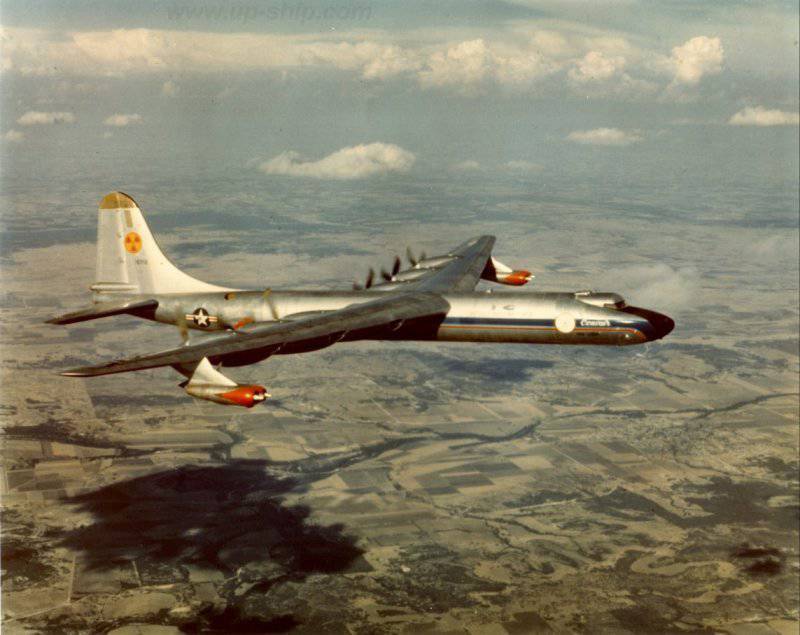
The test flights of the NB-36H laboratory looked as follows: the pilots flew the plane into the air with the reactor jammed, flew into the test zone over the nearest desert, where they conducted all the experiments. At the end of the experiments, the reactor was turned off, and the plane returned to the base. Together with the "Crusader" from the airfield Karswell took off another B-36 bomber with test equipment and a transport ship with paratroopers-marines. In the event of the crash of a prototype aircraft, the marines were to parachute near the rubble, cordon off the area and take part in the aftermath of the accident. Fortunately, all 47 flights with a working reactor did without forced rescue landing. Test flights have shown that an aircraft with a nuclear power plant does not pose any serious danger to the environment, of course, with proper operation and the absence of any incidents.
The second flying lab labeled X-6 also had to be redone from a B-36 bomber. On this plane they were going to install a cockpit similar to the Crusader unit, and in the middle part of the fuselage to mount an atomic power plant. The latter was designed on the basis of the P-1 installation and equipped with new GE XJ39 engines, created on the basis of J47 turbojet. Each of the four engines had traction in 3100 kgf. Interestingly, the nuclear power plant was a monoblock, designed for installation on an aircraft just before the flight. After landing, the X-6 was planned to be driven into a specially equipped hangar, removed the reactor with the engines and put them in a special storage. At this stage, a special purge installation was also created. The fact is that after stopping the jet engine compressors, the reactor stopped cooling with sufficient efficiency, and additional means were required to ensure the safe shutdown of the reactor.
Pre-flight check
Before the start of flights of aircraft with full-fledged nuclear power installation, American engineers decided to conduct relevant research in ground laboratories. In 1955, the experimental setup HTRE-1 (Heat Transfer Reactor Experiments - “Experiments with heat transfer from the reactor”) was assembled. The 50-ton unit was assembled at the base of the railway platform. Thus, before the start of experiments, it could be taken away from people. In the HTRE-1 unit, a compact uranium reactor with protection was used, in which beryllium and mercury were used. Also on the platform placed two engines JX39. They were started using kerosene, then the engines went to working speed, and then, at the command of the control panel, the air from the compressor was redirected to the working zone of the reactor. A typical experiment with the HTRE-1 lasted for several hours, so the long flight of a bomber was simulated. By the middle of 56, the experimental unit had reached a thermal output of over 20 megawatts.
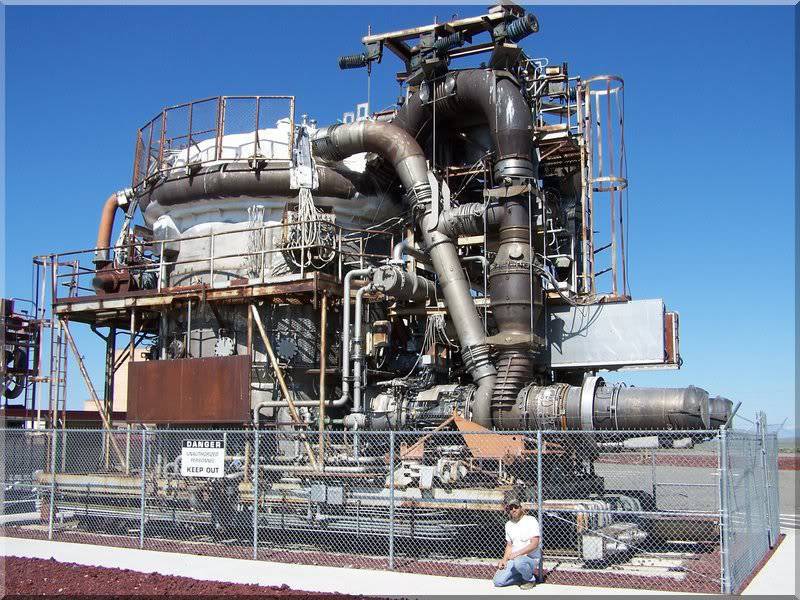
Later, the HTRE-1 installation was remade in accordance with the updated project, after which it was named HTRE-2. New reactor and new technical solutions provided power in 14 MW. However, the second version of the experimental power plant was too large for installation on aircraft. Therefore, by the 1957, construction of the HTRE-3 system began. It was a deeply modernized P-1 system, adapted to work with two turbojet engines. The compact and lightweight HTRE-3 system provided thermal power in 35 megawatts. In the spring of 1958, trials of the third version of the ground-based test complex began, which fully confirmed all calculations and, most importantly, the prospects for such an energy installation.
Uneasy closed circuit
While General Electric was prioritizing open circuit engines, Pratt & Whitney wasted no time in developing its own version of a closed nuclear power plant. Pratt & Whitney immediately began investigating two versions of such systems. The first implied the most obvious structure and operation of the installation: the coolant circulates in the core and transfers heat to the corresponding part of the jet engine. In the second case, it was proposed to grind the nuclear fuel and place it directly into the coolant. In such a system, the fuel would circulate throughout the entire coolant circuit, but nuclear fission would occur only in the core. It was supposed to achieve this with the help of the correct shape of the main volume of the reactor and pipelines. As a result of the research, it was possible to determine the most effective shapes and sizes of such a system of pipelines for circulating the coolant with fuel, which ensured the efficient operation of the reactor and helped to provide a good level of protection from radiation.
At the same time, the circulating fuel system proved to be too complex. Further development mainly followed the path of "stationary" fuel elements washed by a metal coolant. Various materials were considered as the latter, however, difficulties with the corrosion resistance of pipelines and the provision of circulation of liquid metal did not allow us to dwell on the metal coolant. As a result, the reactor had to be designed to use highly superheated water. According to calculations, the water should have reached a temperature of about 810-820 ° in the reactor. To keep it in a liquid state, it was necessary to create a pressure in the system of about 350 kg / cm 1960. The system turned out to be very complex, but much simpler and more suitable than a reactor with a metal coolant. By XNUMX, Pratt & Whitney had completed work on their nuclear power plant for aircraft. Preparations began for testing the finished system, but in the end these tests did not take place.
Sad end
NEPA and ANP programs helped create dozens of new technologies, as well as master a number of interesting know-how. However, their main goal - the creation of an aircraft - even in the 1960 year could not be achieved in the coming years. In 1961, John F. Kennedy came to power, who immediately became interested in advances in the field of nuclear technology for aviation. Since they were not observed, and the program costs reached completely obscene values, the fate of the ANP and all the atoms was a big question. Over a decade and a half, more than a billion dollars was spent on research, design, construction of various test units. At the same time, the construction of a finished aircraft with a nuclear power plant was still a matter of the distant future. Of course, the additional costs of money and time could bring atom vehicles to practical use. However, the Kennedy administration decided differently. The cost of the ANP has steadily increased, but there has been no result. In addition, ballistic missiles have fully proven their high potential. In the first half of 61, the new president signed a document, according to which all work on nuclear aircraft should be stopped. It is worth noting, shortly before, in 60, the Pentagon made a controversial decision, according to which all work on open-type power plants was stopped, and all funding was given to “closed” systems.
Despite some successes in the creation of nuclear power plants for aviation, the ANP program was found to be unsuccessful. For some time, simultaneously with ANP, nuclear engines for advanced missiles were developed. However, these projects did not give the expected result. Over time, they were closed, and work in the direction of nuclear power plants for aircraft and missiles completely stopped. From time to time, various private companies tried to conduct such developments on an initiative basis, but none of these projects received government support. The American leadership, having lost faith in the prospects of nuclear power, began to develop nuclear power plants for fleet and nuclear power plants.
On the materials of the sites:
http://vfk1.narod.ru/
http://hq.nasa.gov/
http://air-and-space.com/
http://airwar.ru/
http://nkj.ru/
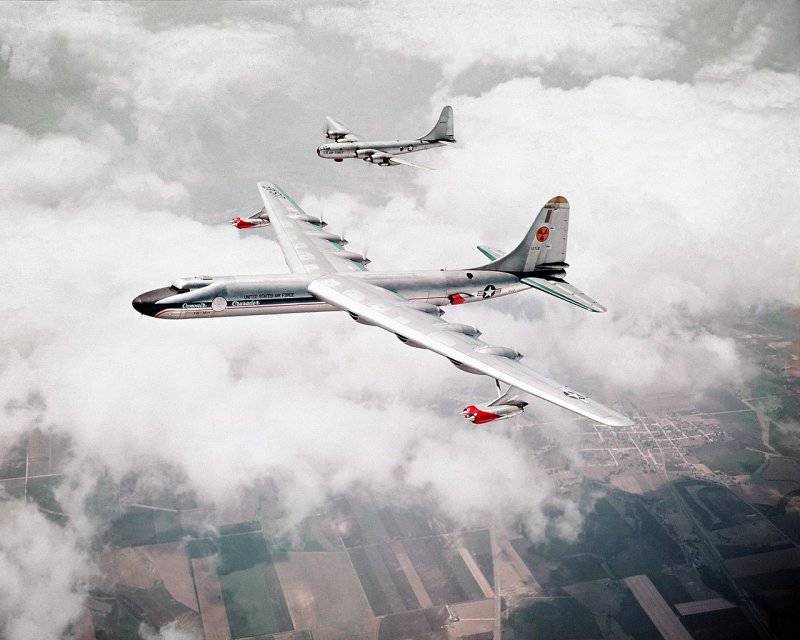
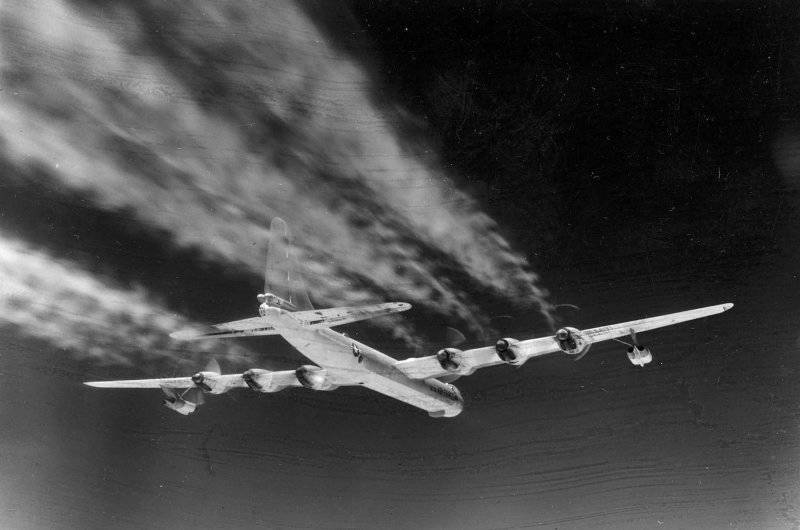
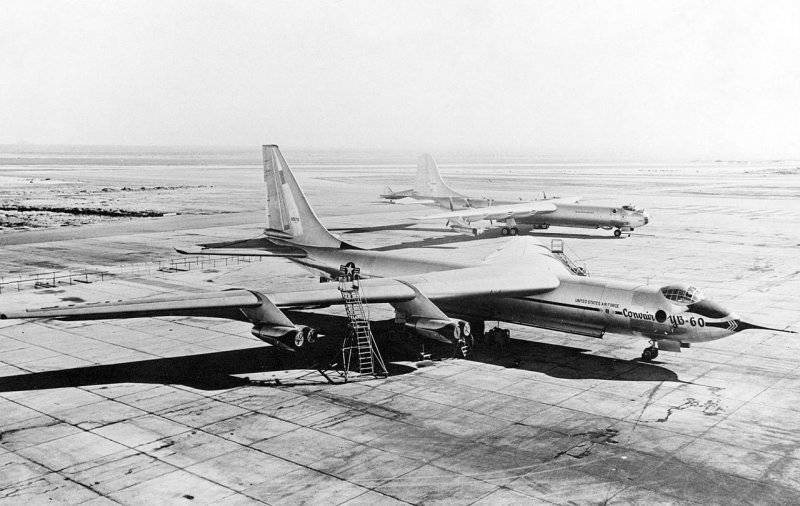
Information